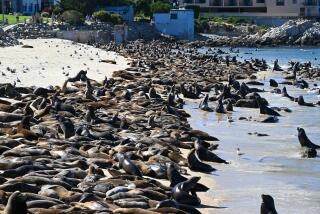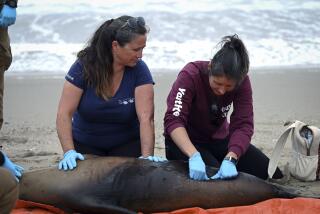Channel Island foxes removed from endangered species list
- Share via
Not long ago, foxes native to the Channel Islands off the California coast teetered on the edge of extinction.
They have rebounded to the point where U.S. wildlife officials on Thursday removed three subspecies of island fox from the roster of federally endangered species, hailing their comeback as the fastest recovery of any mammal listed under the Endangered Species Act.
The diminutive foxes that roam San Miguel, Santa Rosa and Santa Cruz islands were placed on the endangered list in 2004 after their populations were nearly wiped out by golden eagles.
Scientists credited the swift recovery to an effort to relocate predators and breed foxes in captivity so they can be reintroduced to the wild.
“We’re ecstatic that we’ve reached this point so quickly,” said Steve Henry, field supervisor of the U.S. Fish and Wildlife Service’s office in Ventura.
About the size of a house cat, the island fox — with its gray coat and reddish-brown ears — is only found on six of the eight Channel Islands, where it has lived for thousands of years.
Populations have returned to self-sustaining levels ranging from an estimated 700 foxes on San Miguel Island to 2,100 foxes on Santa Cruz Island.
Long inhabited by Native Americans, the Channel Islands later became home to European explorers, ranchers, farmers and the military. Activities on the islands allowed nonnative animals such as pigs, sheep, deer and elk to flourish. Golden eagles migrated there after native, fish-eating bald eagles were wiped out by the dumping of the now-banned chemical DDT off the coast.
The golden eagles preyed on piglets and hunted foxes. By 2000, there were only 15 foxes each on San Miguel and Santa Rosa islands and 55 foxes on Santa Cruz Island.
The race to save the foxes began several years before they were listed as endangered. The wildlife service partnered with the National Park Service, Nature Conservancy and Catalina Island Conservancy to hatch an aggressive plan that included moving golden eagles to Northern California, reintroducing bald eagles to the islands, vaccinating foxes and breeding them in captivity.
The effort was not without controversy. Thousands of pigs were shot and killed, angering animal rights groups. Wildlife officials said eliminating pigs was necessary to force golden eagles to forage elsewhere and help the foxes bounce back.
The islands’ remoteness also played a key role in the foxes’ resurgence, giving scientists better control over recovery efforts than if they happened on the mainland.
Years ago, “you would not have seen a fox. Now, you go out there and you don’t have to wait very long before a fox crosses your path,” said Scott Morrison of the Nature Conservancy, which co-owns Santa Cruz Island.
Funding for the yearslong recovery came from public and private sources and included volunteer time. Officials did not have an estimate of the overall cost, but said the captive rearing and monitoring portions of the program cost about $20 million.
With the fox delisting, 19 animals and plants have been pulled from the endangered species list since President Obama took office, more than previous administrations, wildlife service director Dan Ashe said.
The last U.S. mammal to be removed from the list in record time was the eastern Steller sea lion in 2013 after more than two decades. Since the Endangered Species Act passed in 1973, 37 species have recovered.
Biologists planned to monitor foxes on the northern Channel Islands by conducting periodic health checks and tagging select foxes with radio collars.
Foxes on Santa Catalina Island — a tourist destination — also are recovering but not as fast as their counterparts on the northern Channel Islands. Their numbers plummeted in the 1990s after an outbreak of canine distemper, presumably brought over from the mainland.
Federal officials downgraded the status of the Catalina foxes from endangered to threatened because disease outbreak remains a concern.
ALSO:
A 400-year-old shark? Greenland shark could be Earth’s longest-lived vertebrate
SoCal hit with worst smog in years as hot, stagnant weather brings surge in hospital visits
Perseid meteor shower 2016: Once in a decade ‘outburst’ expected
More to Read
Sign up for Essential California
The most important California stories and recommendations in your inbox every morning.
You may occasionally receive promotional content from the Los Angeles Times.










